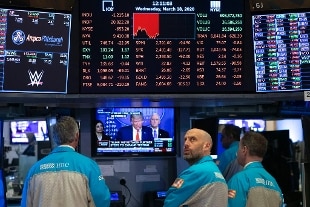Share
June 16, 2020 Retail sales in the US rebounded in May, thanks to the reopenings and rose by 17.7% monthly, against the contraction of 14.7% (data revised from the initial -16.4%) in April. Analysts had expected a much smaller 8% rise. On an annual basis, sales fell by 6.1%, compared to -17.2 (data revised from the initial -21.6%) in April. Analysts predicted a 24.6% drop. The data are particularly significant because they are among the first US macro data for the month of May.Good news also for US industrial production, which rose 1.4% monthly in May, against -12.5% (data revised from the initial -11.2%) in April. Analysts had expected a 2% rise. On an annual basis, production fell by 15.3%, after -15% in April and against an expected -18%. This is a rather weak sign of recovery in the US economy, which reopened in May, while it was in full lockdown in April. The data are particularly significant precisely because they are among the first US macro data in May.
Trump rejoices
"Wow! Retail sales in May show the biggest monthly increase of all time, an increase of 17.7%. Much better than expected. It looks like a great day for the market and jobs." The President of the United States, Donald Trump, wrote on Twitter, commenting on the US retail sales data.
Fed Damps Enthusiasm
The US economic recovery depends on whether the virus is under control, Fed President Jerome Powell said. But at the same time, he added, until confidence in the disease is contained, "full recovery is unlikely," he said in a speech to the Senate Banking Committee. Despite some recent positive signs, there remains "significant uncertainty" about the recovery of the US economy after the blow hit by the coronavirus pandemic, Powell said, promising once again that the Fed will use all its policy tools to help ensure recovery, which, he said, dealt the worst blows to low-income citizens and minorities.
Despite a surprising rebound in employment in May, the economy has lost nearly 20 million jobs since February and the contraction of GDP in the April-June quarter "is probably the most severe ever," warned the head of the Fed. Despite some promising data, such as the data on retail sales, "the levels of production and employment - he continued - remain far below the levels preceding the pandemic and there remains a significant uncertainty regarding timing and strength of recovery ". Among other things, he added, the economic burden resulting from the closure of the business to contain the spread of the virus "did not fall equally on all Americans". Instead, those least able to resist the crisis were the hardest hit, "with the heaviest job losses suffered by Hispanics, African Americans and women." If it is not contained and reversed, the recession could further widen the gaps in well-being economic ", he added.
Even before the blocking measures had full effect at national level, the Fed had zeroed interest rates and increased liquidity, and then launched a series of loan programs to support businesses and governments state and local. In this regard, the Fed president assured: "We are committed to using our full range of tools to support the economy and to help ensure that the recovery from this difficult period is as robust as possible." However, Fed actions "are only part of a wider public sector response", and the direct support that only Congress can provide "can make a critical difference. N not only in helping families and businesses in times of need, but also in limiting lasting damage to our economy ".

